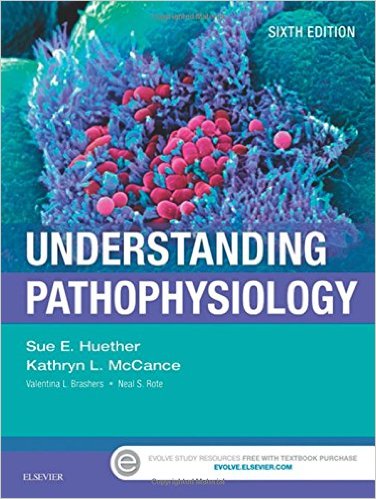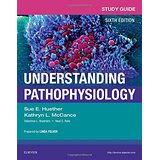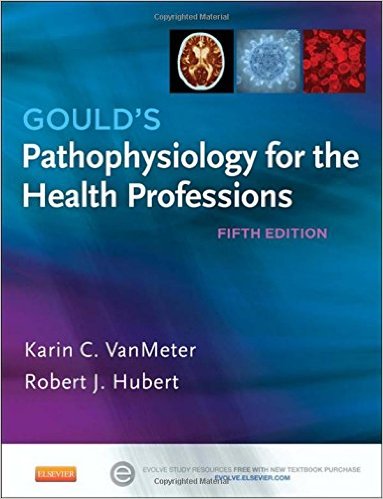| Course Number: | NR281 |
|---|---|
| Course Title: | Pathophysiology I |
| Credit Hours: | 2 credits |
| Theory Hours: | 2 |
| Laboratory Hours: | 0 |
| Clinical Hours: | 0 |
| Place in Curriculum | Year 2, Semester 1 |
| Prerequisite: | BIOS251; BIOS252; BIOS255; BIOS256; MATH114 |
| Corequisite: | None |
Syllabus
Overview
Course Description
The first of two courses which explores select pathophysiologic processes of disease, clinical manifestations, complications and variations in wellness. Environmental and lifestyle influences are examined.
Textbooks and Resources
Required Textbooks
The following books are required for this course:
Huether, S., & McCance, K. (2017). Understanding pathophysiology (6th ed.). St. Louis, MO: Elsevier.
Huether, S., & McCance, K. (2017). Understanding pathophysiology: Study guide and workbook (6th ed.). St. Louis, MO: Elsevier.

American Psychological Association. (2010). Publication manual of the American Psychological Association (6th ed.). Washington, DC: Author.
Optional Textbooks
The following books are required for this course:
VanMeter, Karin C. and Robert J. Hubert. (2014). Gould's Pathophysiology for the Health Professions. (5th ed.). St. Louis, Missouri: Elsevier.
VanMeter, Karin C. and Robert J. Hubert. (2014). Study Guide for Gould's Pathophysiology for the Health Professions. (5th ed.). St. Louis, Missouri: Elsevier.
Physical Books and Supplies
To obtain all your books and supplies, visit the online Chamberlain bookstore at https://bookstore.chamberlain.edu/.
eBook Details
First Time Using VitalSource?
Step 1: View the VitalSource Video
Step 2: Register with VitalSource Bookshelf Online
- Click the cover or title of your eBook. A new window will open.
- Enter email address and password. Bookshelf Online will open.
Step 3: Access the Desktop and Mobile Versions
You must complete Step 2 prior to using the desktop or mobile versions.
Already Registered? 3 Ways to Access Your eBooks

Online
Access your eBook by clicking on the book cover or title in the syllabus page. Bookshelf Online will open.

Desktop
Download your eBooks and use them whether you're connected to the Internet or not.

Mobile
Download the app and get your eBooks on your iPhone, iPad, or Android device.
Program Outcomes
The outcomes for the Bachelor of Science in Nursing (BSN) degree program are as follows:
1
Provides individualized comprehensive care based on theories and principles of nursing and related disciplines to individuals, families, aggregates and communities, from entry to the healthcare system through long-term planning.
2
Demonstrates leadership and collaboration with consumers and other healthcare providers in providing care and/or delegating responsibilities for health promotion, illness prevention, health restoration, health maintenance and rehabilitative activities.
3
Communicates effectively with patient populations and other healthcare providers in managing the healthcare of individuals, families, aggregates and communities.
4
Integrates clinical judgment in professional decision making and implementation of the nursing process.
5
Demonstrates responsibility for continued personal and professional development through enrollment in graduate education, continuing education degree programs, professional reading and participation in professional organizations and community service.
6
Implements professional nursing standards by practicing within the legal definitions of nursing practice and acts in accordance with the nursing code of ethics and American Nurses Association (ANA) standards of practice.
7
Practices in established professional roles consistent with entry-level BSN graduates to provide cost-effective, quality healthcare to consumers in structured and unstructured settings.
8
Incorporates evidence-based practice in the provision of professional nursing care to individuals, families, aggregates and communities.
Course Outcomes
Chamberlain College of Nursing courses are built to align course content with specific Course Outcomes (COs). The COs define the learning objectives that the student will be required to comprehend and demonstrate by course completion. Unit outcomes provide further detail to support learner achievement of specific COs and are listed within each unit under the introduction. Whenever possible, a reference will be made from a particular assignment or discussion back to the CO that it emphasizes.
Upon completion of this course, the student will be able to do the following.
1
Explain the pathophysiologic processes of select health conditions. (PO 1)
2
Predict clinical manifestations and complications of select disease processes. (POs 1, 4, and 8)
3
Correlate lifestyle, environmental, and other influences with changes in levels of wellness. (POs 1 and 7)
Key Concepts
1
Alterations in Cell and Tissue Function
- Cellular Adaptation
- Cellular Injury
- Cellular Response to Aging
2
Genetic and Genomic Basis of Disease
- Characteristics of Chromosomal Disorders
- Development and Transmission of Single-Gene and Multifactoral Genetic Diseases
- Genetic Mapping
- Environmental and Developmental Influences on Expression of Genetic Abnormalities
3
Alterations in Mechanisms of Defense
(Review first and second lines of defense and components of cellular defense; the development, differentiation and roles of neutrophils, macrophages, mast cells, and platelets in inflammation.)
- Inflammation and the Inflammatory Process
- Immunity and Immune Responses
- Stress Response
- Infectious Process
- Environmental Impact on Lines of Defense
- Impact of Aging on Defense Mechanisms
- Hypersensitivity Responses and Life-Threatening Conditions Associated with Hypersensitivity
4
Cancer
- Genetic Influences on Cancer Development
- Cellular and Tissue Differentiation and Tumor Classification
- Environmental and Developmental Influences
- Diagnosis and Hallmarks of Cancer
- Aging and Cancer
5
Alterations in the Hematology System
- Hematologic Response to Illness and Injury
- Cancers of the Hematologic System
- Pathophysiologic Hematologic System Response to Aging
- Genetic Influences on Hematologic System Pathology
6
Alterations in the Integumentary System
- Pathological Processes in Skin Structure and Function
- Genetic and Environmental Influences on Integumentary System Pathology and Cancers
- Pathophysiologic Integumentary System Response to Aging
7
Alterations in the Pulmonary System
- Genetic Influences on Pulmonary Pathology
- Pathophysiologic Processes in Perfusion, Oxygenation, and Ventilation
- Cancers of the Pulmonary System and Responses to Aging
- Environmental and Socio-Cultural-Economic Influences on Pulmonary Disorders
8
Alterations in the Cardiovascular System
- Alterations in Structure and Function of the Heart and Vasculature
- Genetic and Genomic Influences in Cardiac Disorders
- Environmental and Socio-Cultural-Economic Influence on Cardiovascular Disorders
- Normal and Pathophysiologic Responses to Aging
Learning Plan
Download and review the NR281 Pathophysiology I Learning Plan. This learning plan provides a list of unit outcomes and detailed key topics covered in the course.
Required Uniform Assignments (RUAs)
Required Uniform Assignments (RUAs) are essential elements of assessment that are consistent across the curriculum at Chamberlain College of Nursing. These assessments help measure and track students' progress in meeting the BSN Program Outcomes. Each RUA is course-specific and required in both online and campus courses. Download the Pathyphysiological Processes guidelines and grading rubric to begin planning for the successful completion of this assignment.
If you have any questions about the assignment please speak to your instructor.
Course Schedule
| Unit, COs, and Topics | Readings | Assignments |
|---|---|---|
Unit 1 COs 1, 2, and 3 Introduction to Pathophysiology, Fluid Electrolyte and Acid-Base Imbalances | Van Meter, K. & Hubert, R. (2014). Gould's pathophysiology for the health professions (5th ed.) St. Louis, MO: Elsevier.
Van Meter, K. & Hubert, R. (2014). Gould's pathophysiology for the health professions: Study Guide (5th ed.) St. Louis, MO: Elsevier. Suggested Worksheet 1,2 | Faculty Selected Assignments, as instructed |
Unit 2 COs 1, 2, and 3 Genetics and Congenital Disorders | Van Meter, K. & Hubert, R. (2014). Gould's pathophysiology for the health professions (5th ed.) St. Louis, MO: Elsevier.
Van Meter, K. & Hubert, R. (2014). Gould's pathophysiology for the health professions: Study Guide (5th ed.) St. Louis, MO: Elsevier. Suggested Worksheet 21 | Faculty Selected Assignments, as instructed
|
| Exam 1 (Units 1 and 2) | ||
Unit 3 COs 1, 2, and 3 Inflammation, Infection, and Immunity | Van Meter, K. & Hubert, R. (2014). Gould's pathophysiology for the health professions (5th ed.) St. Louis, MO: Elsevier.
Van Meter, K. & Hubert, R. (2014). Gould's pathophysiology for the health professions: Study Guide (5th ed.) St. Louis, MO: Elsevier. Suggested Worksheet 5,6,7 | Faculty Selected Assignments, as instructed |
Unit 4 COs 1, 2, and 3 Neoplasms and Cancer | Van Meter, K. & Hubert, R. (2014). Gould's pathophysiology for the health professions (5th ed.) St. Louis, MO: Elsevier.
Van Meter, K. & Hubert, R. (2014). Gould's pathophysiology for the health professions: Study Guide (5th ed.) St. Louis, MO: Elsevier. Suggested Worksheet 20 | Faculty Selected Assignments, as instructed
|
| Exam 2 (Units 3 and 4) | ||
Unit 5 COs 1, 2, and 3 Skin and Blood and Circulatory System Disorders | Van Meter, K. & Hubert, R. (2014). Gould's pathophysiology for the health professions (5th ed.) St. Louis, MO: Elsevier.
Van Meter, K. & Hubert, R. (2014). Gould's pathophysiology for the health professions: Study Guide (5th ed.) St. Louis, MO: Elsevier. Suggested Worksheet 8,10 | Faculty Selected Assignments, as instructed
|
Unit 6 COs 1, 2, and 3 Respiratory Disorders | Van Meter, K. & Hubert, R. (2014). Gould's pathophysiology for the health professions (5th ed.) St. Louis, MO: Elsevier.
Van Meter, K. & Hubert, R. (2014). Gould's pathophysiology for the health professions: Study Guide (5th ed.) St. Louis, MO: Elsevier. Suggested Worksheet 13 | Faculty Selected Assignments, as instructed |
| Exam 3 (Units 5 and 6) | ||
Unit 7 COs 1, 2, and 3 Cardiovascular Disorders | Van Meter, K. & Hubert, R. (2014). Gould's pathophysiology for the health professions (5th ed.) St. Louis, MO: Elsevier.
Van Meter, K. & Hubert, R. (2014). Gould's pathophysiology for the health professions: Study Guide (5th ed.) St. Louis, MO: Elsevier. Suggested Worksheet 12 | Faculty Selected Assignments, as instructed |
Unit 8 Wrap It Up | Van Meter, K. & Hubert, R. (2014). Gould's pathophysiology for the health professions (5th ed.) St. Louis, MO: Elsevier.
| Faculty Selected Assignments, as instructed Final Exam |
Attendance Policy
Regular attendance and consistent participation within the classroom, lab, and clinical experiences facilitate the achievement of course outcomes set forth in the course syllabi. Students must arrive on time and stay for the duration of the class meeting, lab, and/or clinical experience. Late arrival may result in denied access to the class. Absences and/or tardiness from lecture, pre-clinical, clinical (including pre- and post-conferences), and/or lab experiences (including pre- and debriefing) may prohibit students from completing all components of the nursing course, resulting in course failure.
Attendance is tracked for all eight weeks of the session on a course-by-course basis and is recorded daily based on academic events. An academic event for onsite courses is defined by attending scheduled class meetings. An academic event for online courses is defined by submitting a class assignment, participating in threaded discussions, or completing quizzes and exams. An academic event for blended courses is defined by attendance in the onsite component or by submitting a class assignment, participating in threaded discussions or completing quizzes and exams in the online component.
Due Dates for Assignments and Exams
Unless otherwise specified, the following applies.
- Access to the course begins on Sunday at 12:01 a.m. (MT) during preview week.
- All completed assignments are to be submitted to the Dropbox on or before Friday by 5:00 p.m. Mountain Time (MT) or as specified by your faculty.
- All quizzes and exams, if applicable in your course, are offered at specific times.
- Campus Courses: Campus faculty will share the date, time, and location with students at the beginning of each session.
- Online Courses: Online faculty will share online exam schedule with students during preview week in a course announcement. Students should refer to the posted announcement for the specific dates and times for their exam schedule.
Note: In Unit 8 the assignments will be due by Wednesday at 11:59 p.m. MT.
If you are taking this course on campus, a course calendar includes detailed information related to activities and due dates may be available for downloading from Doc Sharing. Please check with your instructor for more information.
If you are taking this course online, Please be advised that you may be required to take your tests on the campus in a proctored environment. Your campus will post the date, time and location of exams. If testing will take place online, the online faculty will share the exam schedule with students during preview week in a course announcement. Students should refer to the posted announcement for the specific dates and times for their exam schedule.
Assignment Values and Letter Grades
The maximum score in this class is 1,000 points. The categories, which contribute to your final grade, are weighted as follows.
| Assignment | Points | Weighting |
|---|---|---|
| Examinations* | ||
| Exam 1 | 200 | 20% |
| Exam 2 | 200 | 20% |
| Exam 3 | 200 | 20% |
| Comprehensive Final Exam | 200 | 20% |
| *Must achieve an average of 76% to pass the course | ||
| Assignments | ||
| Pathophysiological Processes (RUA) | 50 | 5% |
| Faculty Selected Assignments | 150 | 15% |
| Total Points | 1,000 | 100% |
| Letter Grade | Points | Percentage |
|---|---|---|
| A | 940–1,000 | 94% to 100% |
| A- | 920–939 | 92% to 93% |
| B+ | 890–919 | 89% to 91% |
| B | 860–889 | 86% to 88% |
| B- | 840–859 | 84% to 85% |
| C+ | 810–839 | 81% to 83% |
| C | 760–809 | 76% to 80% |
| F | 759 and below | 75% and below |
Teaching/Learning Methods
Examples include, but are not limited to
- assignments;
- case studies;
- discussion;
- experiential learning
- group assignments;
- lectures; and
- multimedia presentations.



